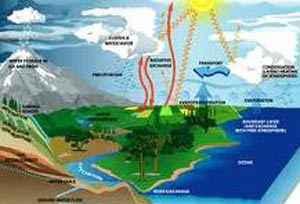Hydrological cycle is the circulation of water that never stops from
the atmosphere to earth and back into the atmosphere through
condensation, precipitation, evaporation and transpiration. Warming
ocean water by sunlight is the key process of the hydrologic cycle can
run continuously. exploration water, then fall as precipitation in the
form of rain, snow, hail, sleet and snow (sleet), light rain or fog. On
the way to earth some precipitation may exploration back up or straight
down which is then intercepted by plants before it reaches the ground.
After reaching land, the hydrologic cycle continues to move continuously in three different ways
1. Evaporation / transpiration – water of the sea, on land, in rivers, in plants, etc.. will then evaporate into the air (atmosphere) and then will be a cloud. In the saturated state of water vapor (clouds) will go to spots which in turn would decrease water (precipitation) in the form of rain, snow, ice.
2. Infiltration / percolation into the soil – water moves into the soil through cracks and pores of soil and rock into groundwater. Water can move due to capillary action or water can move vertically or horizontally below the soil surface until the water re-entering the surface water system.
3. Surface Water – Water moving over the soil surface close to main stream and lake; more sloping land and fewer and fewer of the pores of the soil, the greater the surface flow. The flow of the soil surface can be seen usually in urban areas. The rivers join each other and form a major river that carries all the surface water around the watershed to the sea. Surface water, either flowing or stagnant (lakes, reservoirs, swamps), and partly below the surface water will be collected and flow to form the river and ended at the sea.
The process of water traveling in the mainland took place in the hydrological cycle components that make up systems of the Watershed (DAS). The amount of water on earth as a whole is relatively fixed, the change is the form and place.
After reaching land, the hydrologic cycle continues to move continuously in three different ways
1. Evaporation / transpiration – water of the sea, on land, in rivers, in plants, etc.. will then evaporate into the air (atmosphere) and then will be a cloud. In the saturated state of water vapor (clouds) will go to spots which in turn would decrease water (precipitation) in the form of rain, snow, ice.
2. Infiltration / percolation into the soil – water moves into the soil through cracks and pores of soil and rock into groundwater. Water can move due to capillary action or water can move vertically or horizontally below the soil surface until the water re-entering the surface water system.
3. Surface Water – Water moving over the soil surface close to main stream and lake; more sloping land and fewer and fewer of the pores of the soil, the greater the surface flow. The flow of the soil surface can be seen usually in urban areas. The rivers join each other and form a major river that carries all the surface water around the watershed to the sea. Surface water, either flowing or stagnant (lakes, reservoirs, swamps), and partly below the surface water will be collected and flow to form the river and ended at the sea.
The process of water traveling in the mainland took place in the hydrological cycle components that make up systems of the Watershed (DAS). The amount of water on earth as a whole is relatively fixed, the change is the form and place.



No comments:
Post a Comment